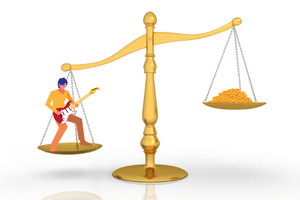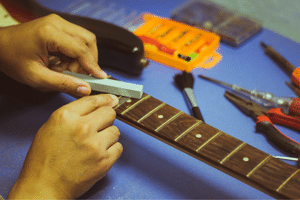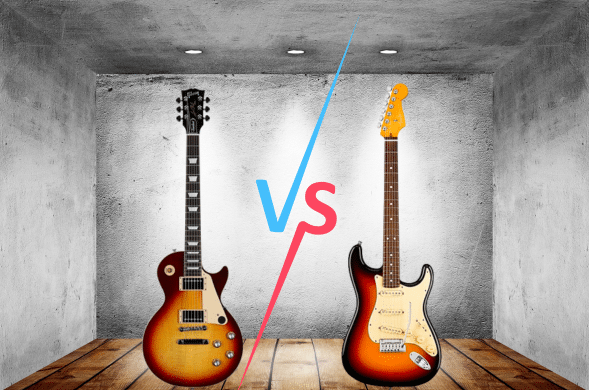It’s the age-old debate that has guitarists strumming their six strings in contemplation: Les Paul Vs Stratocaster. You’ve likely stumbled upon this heated discussion if you’ve ever set foot in a guitar shop or scrolled through a music forum.
But fear not because we’re about to dive into a comprehensive comparison that will help you make an informed decision, whether you’re a newbie or a seasoned shredder!
Keep reading – the answers you seek are coming up!
You can use the table of contents below to take you to the area that interests you. Click on the little box to open it, and then click on the section of the article you want to read, or you can read from start to finish if you want the full guitar comparison experience!
The Short Answer
Choosing between a Les Paul and a Stratocaster largely depends on your musical preferences, playing style, and comfort needs. Les Pauls offer warm, rich tones ideal for genres like Rock, Metal, and Blues, while Stratocasters have bright, clear sound with versatility across multiple genres. Strats are generally lighter and more ergonomic, whereas Les Pauls have a solid, heavier feel. Budget considerations and customization options can also play a role.
Keep On Reading (Below) To Learn More
A Quick Comparison

Before we dive into the nitty-gritty details, let’s set the stage with some essential differences between these two titans of the guitar world. I like to use a car analogy.
The Les Paul is often described as the “luxury car” of guitars – elegant, sophisticated, and a bit on the heavier side. It’s the guitar you’d likely see in a smoky jazz club or a classic rock concert.
It’s easier to play, just like a Cadillac is easier to drive with power brakes and steering.
The Stratocaster, on the other hand, is more like the “sports car” of guitars- sleek, fast, and versatile. It’s the choice for the experimentalist, the genre-hopper, and the stage-roamer. Whether you’re into Blues, Rock, Surf Rock, Funk, or Country, the Strat’s got your back.
However, a Strat can be more challenging but more fun to play than a Les Paul, like a vintage roadster that has to be in the right gear. Turning at slower speeds is tighter, but the roadster is great around the winding curves.
So, each guitar has its distinctive sound, feel, and playability that appeals to various players. Neither is better than the other; simply a different experience!
The Origins Of These Guitars
In case you don’t know, here are the events that were instrumental (pun intended) in bringing these guitars into the world.
The Birth Of The Les Paul
Let’s start with a bit of history, shall we? The Les Paul was born out of a collaboration between the legendary guitarist Les Paul and the Gibson Guitar Corporation. Launched in 1952, this iconic guitar quickly became a staple in the music industry. It’s not just a guitar; it’s a piece of musical history that has shaped genres from Blues to Hard Rock.
The Design Of The Stratocaster
On the flip side, we have the Stratocaster, lovingly known as the “Strat.” Introduced by Leo Fender in 1954, this guitar was designed with the modern musician in mind. It’s lighter, more ergonomic, and built for versatility. The Stratocaster has been the go-to axe for countless musicians, from Jimi Hendrix to John Mayer.
How To Choose Between A Les Paul And A Strat

Choosing between these two iconic guitars boils down to four key factors: your musical taste, playing style, comfort preferences, and budget. Here’s a straightforward method to help you decide:
Step 1: Identify Your Musical Taste
First, think about the genres you love and want to play. Although each type of guitar can handle any musical genre, a Les Paul can give you more power and sustain with a warmer tone, whereas a Strat can give you a brighter tone with a more biting attack.
Step 2: Consider Your Playing Style
Are you more of a rhythm player, or do you see yourself shredding solos? Les Pauls are great for thick, saturated tones, ideal for powerful chords and emotive solos. Stratocasters offer more tonal versatility, making them suitable for both rhythm and lead roles that can cut through the band.
Comfort Is Key
Consider the guitar’s weight and how it feels when you hold it. Les Pauls are generally heavier and might be less comfortable during long gigs. Stratocasters are lighter and have ergonomic body carves, making them easier to play for extended periods.
Step 4: Budget
Last but not least, consider how much you’re willing to spend. Les Paul and Stratocaster models come in various price ranges, from entry-level to high-end. Les Pauls tend to be pricier at the mid and high-end levels, while Stratocasters offer more budget-friendly options without compromising on quality.
Remember, a higher price doesn’t always mean a better guitar for you. Balancing your budget with your needs and preferences is essential to find the perfect match.
Keep On Reading (Below) To Learn More About Each Topic
Anatomy Of The Guitars
Here are the basic things that set a Les Paul apart from a Strat in terms of construction and materials, along with a table that summarizes the differences between the two.
Les Paul: Built Like a Tank
When it comes to construction, the Les Paul is the epitome of sturdiness and durability. The body is typically made of mahogany, often with a maple top, which contributes to its weight and rich, warm tone.
The set neck, usually also mahogany, adds to the guitar’s sustain and stability. It’s like the four-wheel-drive of guitars, built to handle anything from bluesy bends to face-melting solos.
Another key feature is the neck’s shorter scale length, usually around 24.75 inches. This makes for a slinkier feel, easier bends, and contributes to the guitar’s warm, fat tone.
The Les Paul is also famous for its humbucker pickups. These are designed to “buck the hum,” reducing unwanted noise while delivering a thicker, fuller sound. It’s the kind of guitar that makes every note feel like a warm hug, especially when you’re digging into those bluesy licks or crunchy rock riffs.
Stratocaster: The Versatile Warrior
The Stratocaster takes a different approach. Its body is usually made of alder or ash, making it lighter and more comfortable for those marathon jam sessions.
The bolt-on neck, often made of maple, adds a snappy quality to the tone and makes it easier to replace in case of damage. It’s like the Swiss Army knife of guitars—ready for any musical challenge you throw its way.
The Strat also features a longer scale length, typically around 25.5 inches, which gives it a brighter tone and a bit more tension under the fingers. This is ideal for fast-playing styles and offers more clarity for complex chord voicings.
What sets the Strat apart is its trio of single-coil pickups. These offer a brighter, more cutting tone compared to the Les Paul’s humbuckers. The Strat’s five-way switch allows for a wide range of tonal options, from the trebly sounds of Rock to the screaming leads of Metal. It’s the go-to guitar for players who love to experiment with different genres and tones.
Fretboard Radius: A Subtle But Significant Difference
The fretboard radius refers to the curvature of the fretboard, and it can affect how the guitar feels in your hands, especially when playing chords or solos.
Les Pauls typically have a more rounded fretboard radius, often around 12 inches. This design is excellent for chordal work and provides a comfortable grip for most hand sizes. Some players find that the flatter radius of a Les Paul can make it easier to execute fast, intricate solos but a little uncomfortable to play chords, especially in the first three to four frets.
Stratocasters, on the other hand, usually feature a more curved fretboard radius, but they can range from 7.25 to 15 inches, depending on the model. A Stratocaster with a mid-radius curvature, like 9.5 inches, can be an excellent compromise that allows you to play rhythm and solos comfortably all over the neck. The flatter radius is generally considered better for lead work, as it allows for easier string bending and faster playability.
For more info on fretboard radius, check out the following articles:
7.25 VS 9.5 Inch Fingerboard Radius – Which Is One Is Better?
9.5 VS 12 Inch Fingerboard Radius – Which Is One Is Better?
Do Strats Have A Compound Radius? – What You Should Know!
Fret Size: Small Details, Big Impact
Fret size can make a noticeable difference in how a guitar feels and plays. Generally speaking, Les Pauls often come with medium-jumbo frets. These are versatile and relatively comfortable for both chordal work and solos, providing a good balance for players who like to mix it up.
Stratocasters, on the other hand, offer a bit more variety in fret sizes, ranging from vintage-style small frets to medium-jumbo and even jumbo frets in some models. Smaller frets are great for intricate chording and offer a “vintage” feel, while larger frets make it easier to bend notes and play fast solos.
So, if you’re a player who loves to dig into solos and wants more room to bend those strings, a Stratocaster with jumbo frets might be your best bet. Conversely, if you’re looking for a balanced feel that’s great for both rhythm and lead, a Les Paul with medium-jumbo frets could be the perfect match.
For more info on fret size, check out the following articles:
Jumbo Vs Medium Jumbo Frets – Find The Perfect Size For You!
How Long Do Guitar Frets Last? – Your Essential Guide!
Important Features Of A Les Paul And Stratocaster
| Feature | Les Paul | Stratocaster |
|---|---|---|
| Body Material | Mahogany (often with Maple top) | Alder/Ash |
| Body Carves | None | Front and Back |
| Neck Type | Set Neck | Bolt-On |
| Neck Material | Mahogany | Maple |
| Fretboard Radius | 12 inches | 7.25 to 15 inches |
| Fret Size | Mainly Medium-Jumbo | Small to Jumbo |
| Scale Length | ~24.75 inches | ~25.5 inches |
| Pickups | Humbuckers | Single-Coil |
| Pickup Selector | 3 combinations | 3 to 5 combinations |
| Volume Controls | 2 (One for Each Pickup) 500K Ohms | 1 (Master Volume) 250K Ohms |
| Tone Controls | 2 (One for Each Pickup) | 2 (One for Neck, One for Middle) |
| Bridge | Tune-O-Matic, Bigsby Optional | Synchronized Tremolo, Hardtail Optional |
| Weight | Heavy (9 to 12 pounds) | Light (7 to 8 pounds) |
Tone And Sound
When it comes to tone, the Les Paul and Stratocaster are like two different dialects in the language of guitar. They both speak “Rock,” “Blues,” and “Jazz,” but with distinct accents and nuances that set them apart.
Les Paul: The “Velvet Voice”
The Les Paul is often described as having a “velvet voice.” Its humbucker pickups and mahogany construction contribute to a warm, rich tone with plenty of sustain. It’s the kind of guitar that can make a single note sing for days. Whether you’re playing a soulful blues solo or laying down some heavy rock riffs, the Les Paul delivers a full-bodied sound that fills the room.
Stratocaster: The “Chameleon”
The Stratocaster, on the other hand, is a tonal chameleon. Its single-coil pickups and longer scale length give it a brighter, more cutting tone. The Strat excels in clarity, making each note stand out, even when you’re playing complex chords or fast licks. Its versatility is its superpower; you can go from a rich jazz sound to a screaming rock solo just by flipping the pickup switch!
Tone Characteristics
| Tone Quality | Les Paul | Stratocaster |
|---|---|---|
| Brightness | Low | High |
| Warmth | High | Moderate |
| Clarity | Moderate | High |
| Versatility | Moderate | High |
| Sustain | High | Moderate |
Genre Suitability
| Genre | Les Paul | Stratocaster |
|---|---|---|
| Blues | Excellent | Very Good |
| Jazz | Excellent | Good |
| Rock | Excellent | Very Good |
| Funk | Moderate | Excellent |
| Metal | Excellent | Very Good |
Stratocasters With A Humbucker: Bridging The Gap To Les Paul Lead Tones

One of the most versatile configurations you can find in a Stratocaster is the HSS setup, which stands for Humbucker-Single-Single. This refers to a humbucker pickup in the bridge position, with single-coil pickups in the middle and neck positions. This unique setup offers a tonal versatility that can bring your Strat closer to the warm, rich tones typically associated with a Les Paul.
Why A Humbucker In The Bridge?
The bridge position is crucial for generating those biting, high-output tones that are perfect for lead guitar work. When you put a humbucker in this position on a Stratocaster, you’re essentially giving it the power to produce the thick, saturated tones that Les Pauls are famous for. This makes it an excellent choice for genres like Rock, Metal, and Blues, where a meatier, higher-output lead tone is often desired.
Versatility At Its Best
What makes this setup even more appealing is that you still retain the classic Strat single-coil pickups in the middle and neck positions. This means you can switch from a warm, Les Paul-like lead tone to the bright, clear Strat tones with a flick of the pickup selector switch. It’s like having the best of both worlds at your fingertips!
There are also Strats available in other single-coil and humbucker configurations, like HSH, HH, and HHH. However, most of the “Super Strats” made for shredding tend to have the HSS or HSH configuration.
For more info, see Super Strat Guitars – Turn Your Strat Into A Shred Machine!
The Bottom Line
If you’re a Strat lover but find yourself yearning for the rich, full lead tones of a Les Paul, an HSS Stratocaster could be your perfect match. It offers a unique blend of tonal options that can satisfy a wide range of musical needs, making it one of the most versatile guitars you can own.
Playability And Comfort
When choosing between a Les Paul and a Stratocaster, the physical feel of the guitar can be a game-changer. Both guitars have their unique ergonomic features that can either enhance or hinder your playing experience.
Les Paul: The Solid Contender
Neck
The Les Paul’s neck profile is generally thicker, often described as a “C” or “D” shape. This can provide a fuller grip, which some players find more comfortable for chord work and bends. However, the thicker neck might be a challenge for those with smaller hands or for players who prefer fast, intricate solos.
Body
The Les Paul body is built like a solid block, with no body carves (contours) on either the front or the back. While this design contributes to its robust tone, it can make the guitar feel less ergonomic during extended play. The lack of body carves means that the guitar sits more flatly against your body, which some players find less comfortable, especially during long gigs or practice sessions.
Stratocaster: The Ergonomic Marvel
Neck
The Stratocaster usually features a slimmer neck, often with a “C” shape that is more tapered towards the nut. This design makes it easier to navigate the fretboard, especially for fast runs and complex chord shapes. The slimmer profile is generally more accommodating for a wider range of hand sizes and playing styles.
Body
The Stratocaster body takes comfort to the next level with its body carves (contours) on both the front and the back. These carves are designed to fit more naturally against your body, reducing fatigue and making it easier to move around while playing.
The front carve allows your picking arm to rest more comfortably against the guitar, while the back carve accommodates your ribcage. It’s like the guitar is giving you a gentle hug, making those marathon jam sessions a breeze.
Playability And Comfort Distinguishing Features
| Factor | Les Paul | Stratocaster |
|---|---|---|
| Neck Profile | Thicker | Slimmer |
| Fret Accessibility | Moderate | Excellent |
| Body | Thicker (no carves) | Thinner (carved front & Back) |
| Balance | Moderate | Excellent |
| Weight | Heavy | Light |
Price And Value: Getting More For Your Money
When it comes to investing in a guitar, the price tag is often a significant consideration. Both Les Paul and Stratocaster guitars come in various price ranges, from entry-level to high-end models. But what do you really get for your money? Let’s break it down.
Entry-Level Models
These are the guitars that won’t break the bank but still offer a decent playing experience.
Les Pauls in this category, like the Epiphone Les Paul Standard, offer a solid introduction to the guitar’s iconic tone.
Stratocasters, such as the Squier Classic Vibe series, provide a budget-friendly way to experience the Strat’s versatility.
Mid-Range Models
This is where you start to see significant improvements in build quality, electronics, and customization options.
Les Pauls, like the Gibson Les Paul Studio, offer upgraded pickups and better tonewoods.
Stratocasters in this range, like the Fender Player Series, come with improved hardware and more versatile pickup configurations.
High-End Models
These are the cream of the crop, often used by professional musicians and serious enthusiasts.
High-end Les Pauls like the Gibson Les Paul Custom offer premium tonewoods, top-of-the-line pickups, and intricate inlays.
Stratocasters in this category, such as the Fender American Ultra, come with advanced electronics, premium materials, and enhanced playability features.
Price Comparison: What You Get At Each Level
| Price Range | Les Paul Models | Stratocaster Models | Key Features |
|---|---|---|---|
| Entry-Level | Epiphone Les Paul Standard (~$400-$600) | Squier Classic Vibe (~$400-$500) | Basic Electronics, Limited Customization |
| Mid-Range | Gibson Les Paul Studio (~$1,200-$1,500) | Fender Player Series (~$700-$900) | Upgraded Pickups, Improved Hardware |
| High-End | Gibson Les Paul Custom (~$4,000-$6,000) | Fender American Ultra (~$1,800-$2,200) | Premium Materials, Advanced Electronics |
Customization
Generally speaking, the Stratocaster is a more versatile guitar than the Les Paul, although both guitars can be customized to the player’s needs.
The Les Paul is often seen as a more “set-in-stone” kind of instrument. Its iconic tones are so deeply ingrained in music history that many players feel little need to alter them. While customization options exist, they often require more invasive modifications, such as coil-splitting or adding a Bigsby tremolo.
The Stratocaster is a playground for sonic experimentation. Its modular design allows for easy part swaps, from pickups to pickguards. Whether you’re a DIY enthusiast or a tone-chaser, the Strat offers numerous possibilities for customization.
Customization Options: Make It Your Own
Tuning Machines: Stability Meets Style
For Les Paul users, upgrading to after-market products like Grover locking tuners can improve tuning stability and add a modern touch to a classic design.
Strat players often opt for Fender Locking Tuners, especially if they use the tremolo bar frequently, to ensure the guitar stays in tune.
Neck: The Personal Touch
Les Paul offers different neck profiles like the SlimTaper for faster play and the ’50s profile for a vintage feel. However, the neck is glued into the guitar body, so you’re stuck with the neck you buy.
Stratocaster players can easily swap out the neck, which is bolted into the body, choosing different wood types and fret sizes to suit their playing style.
Pickups: The Heart of Your Sound
While Les Pauls are known for their humbuckers, swapping to P-90s can give you a grittier, more vintage tone.
Stratocaster players often experiment with Noiseless Single-Coils to maintain the classic Strat sound without the hum or even go for humbuckers for a beefier output.
The Les Paul’s dual humbuckers and three-way switch offer a focused tonal palette, ideal for those who prefer a specific sound.
The Stratocaster, with its three single-coils and five-way switch, provides a broader spectrum, making it a go-to for genre-hopping musicians.
Bridge: The Foundation of Sustain
Les Paul players looking for more vibrato might consider adding a Bigsby, which is less invasive than other tremolo systems.
Strat players have the option of upgrading to a two-point tremolo for smoother action or even a Floyd Rose for dive-bombing antics.
Saddles: The Unsung Heroes
Upgrading to Graph Tech or brass saddles on a Les Paul can improve sustain and add a touch of warmth to your tone.
Strat players often opt for steel saddles for increased sustain and a sharper attack.
Volume and Tone Controls: The Fine-Tuners
Les Pauls often come with audio taper pots for smoother volume swells, but you can add push/pull pots for coil-splitting options.
Strat players might consider no-load pots that completely remove the circuit at 10, allowing the pickups to produce a stronger and more aggressive tone.
Customization Summary
This table gives additional examples of customization choices for each guitar type. Note that some options, like the neck type on a Les Paul, are fixed when the guitar is built. This is by no means a complete table of all the available choices, but it does provide many of the more popular options.
| Customizable Feature | Les Paul Customization Options | Stratocaster Customization Options |
|---|---|---|
| Tuning Machines | Grover Locking, Vintage-style Kluson, Hipshot | Fender Locking, Vintage-style, Sperzel Locking |
| Neck | Different Profiles (SlimTaper, ’50s), Wood Types | Different Profiles (C, V, D), Wood Types, Fret Sizes |
| Pickups | Swap to P-90s, Active Pickups, Different Humbucker Brands | Swap to Humbuckers, Active Pickups, Noiseless Single-Coils |
| Bridge | Add Bigsby, Roller Bridge, Locking Tailpiece | Two-Point Tremolo, Floyd Rose, Hardtail Conversion |
| Saddles | Graph Tech, Brass, Titanium | Graph Tech, Brass, Steel, Titanium |
| Volume Controls | Push/Pull Pots for Coil Splitting, Audio Taper Pots | Push/Pull Pots for Series/Parallel, No-Load Pots |
| Tone Controls | Varitone Switch, Orange Drop Capacitors | TBX Tone Control, Greasebucket Circuit, Capacitor Swaps |
Famous Players And Iconic Songs
When it comes to the Les Paul and the Stratocaster, the list of legendary players and iconic songs is long and illustrious. These guitars have not only shaped the sound of countless hits but have also been the go-to choice for many of the world’s most famous guitarists.
Les Paul: The Guitar Of Rock Gods

Jimmy Page of Led Zeppelin wielded a Les Paul to create some of rock’s most iconic riffs, like the ones in “Whole Lotta Love.”

Slash of Guns N’ Roses is another Les Paul aficionado, famous for the scorching solos in songs like “Sweet Child o’ Mine.”
Stratocaster: The Versatile Virtuoso

Jimi Hendrix made history with a Stratocaster in his hands, delivering groundbreaking performances like his rendition of “The Star-Spangled Banner” at Woodstock.

Eric Clapton, another Strat master, gave us classics like “Layla” and “White Room.”
Musical Icons And Their Anthems
| Guitar Type | Famous Player | Iconic Song | Album/Event | Year | Signature Technique or Gear Used |
|---|---|---|---|---|---|
| Les Paul | Jimmy Page | Whole Lotta Love | Led Zeppelin II | 1969 | Theremin, Slides |
| Les Paul | Slash | Sweet Child o’ Mine | Appetite for Destruction | 1987 | Wah-Wah Pedal, Pinch Harmonics |
| Stratocaster | Jimi Hendrix | Star-Spangled Banner | Woodstock | 1969 | Whammy Bar, Feedback |
| Stratocaster | Eric Clapton | Layla | Layla and Other Assorted Love Songs | 1970 | Dirty Overdrive, Finger Vibrato |
These legendary players and their iconic songs are a testament to the enduring appeal and versatility of the Les Paul and Stratocaster guitars. Whether you’re into rock, blues, or any genre in between, these guitars have been there, done that, and rocked the world.
Expert Opinions On The Les Paul & Stratocaster
When it comes to the eternal debate between the Les Paul and the Stratocaster, different experts bring unique perspectives to the table. Let’s hear what music educators, professional guitarists, and guitar technicians have to say.
Music Educators
Tom Kolb, a renowned guitar instructor, often recommends the Les Paul for students interested in rock and blues, citing its rich tonal palette as a great learning tool.
Wolf Marshall, a respected music educator and author, is known for his work with the Stratocaster. He often highlights its versatility and user-friendly features as ideal for students who are exploring a range of musical styles.
Professional Guitarists
Joe Bonamassa, known for his blues-rock prowess, is a Les Paul aficionado who praises its tonal depth and sustain.
John Mayer, on the other hand, is a Stratocaster enthusiast who appreciates its adaptability across genres, from blues to pop.
Guitar Technicians
Dan Erlewine, a top guitar repairman and author, appreciates the Les Paul for its solid construction, which he says contributes to its tonal excellence.
Dave Schecter, a well-known guitar technician and co-founder of Schecter Guitar Research, praises the Stratocaster for its modular design, making it a dream to customize and repair.
My Personal Experience With Les Pauls & Strats
I played a Stratocaster for years before trying a Les Paul through my rig. One day, I plugged in a late ’60s Les Paul Deluxe with mini humbuckers into my Fender Twin Reverb amp, and I couldn’t believe the difference! The guitar gave the amp a warm overdrive without adding dirt pedals like overdrive or distortion!
That guitar belonged to a friend who brought it to me for repair because the neck pickup kept cutting out. In retrospect, I should have offered to buy the guitar from him, but instead, I repaired it for free, which is what friends do.
Still, I couldn’t help wondering what a Les Paul with full-size humbuckers would sound like, so I went to a local music store to hear the difference. Although the full-size humbuckers were richer sounding and hotter, the mini humbuckers gave me a sound in between a standard Les Paul and a Strat, especially with the bridge pickup.
I have to say, for the kind of music I play, which is mostly Fusion and Rock, I prefer a Stratocaster. However, I think the sound of a Les Paul with mini humbuckers or a Strat with a full-size humbucker in the bridge position is the way to go for one guitar that gives the best of both worlds. So, if you have a limited budget, be sure to try these pickup configurations in a Les Paul and a Strat before you make your choice.
The Sound Showdown: Les Paul Vs. Stratocaster

Despite all the similarities between the Les Paul and Stratocaster guitars, it can be challenging to get the sound of one from the other.
It’s generally easier to get Les Paul sounds from a Strat than it is to get Strat Sounds from a Les Paul.
However, there are a variety of tricks and equipment that can be used to level the playing field. Check out my articles below to get more information.
Related Article ➡ Can A Strat Sound Like A Les Paul? – Trade Secrets Revealed!
Related Article ➡ Can A Les Paul Sound Like A Strat? – Best Tips And Tricks!
Key Takeaways And Final Verdict

Here are the essential points to remember about a Les Paul versus a Stratocaster.
- Pickup Configuration: Les Pauls usually come with humbuckers, ideal for a thicker sound, while Stratocasters typically have single-coil pickups for a brighter tone.
- Wood Matters: The choice of wood in a Les Paul often includes mahogany, which contributes to its warmer tone, whereas Stratocasters frequently use alder or ash for a brighter sound.
- Electronics: Stratocasters often feature a 5-way pickup selector for tonal variety, while Les Pauls usually have a 3-way toggle switch, offering fewer but more distinct tonal options.
- Sustain: Les Pauls are known for their incredible sustain, making them ideal for solos that require long-lasting notes.
- Tremolo System: Stratocasters often come with a tremolo system, allowing for pitch bending and vibrato effects, which is less common in Les Pauls.
- Body Weight: Les Pauls are generally heavier, which some players believe contributes to their fuller sound and sustain, while Stratocasters are lighter and more balanced.
- Resale Value: Both guitars hold their value well, but vintage models of each can fetch astronomical prices, making them not just musical instruments but also investment pieces.
Final Verdict
The most important thing players should keep in mind when deciding between a Les Paul and a Stratocaster is the type of music they want to play and the tonal qualities they seek. Each guitar has its own unique sound profile and features that make it more suited for certain genres and playing styles.
For instance, a Les Paul might be your go-to choice if you are looking for a guitar that excels in producing warm, rich tones ideal for rock, Blues, or Jazz. On the other hand, a Stratocaster might be a better fit if you’re after a more versatile guitar capable of delivering bright, clear tones and want the ability to play across multiple genres like Country, Funk, or Surf Rock.
Playability is important, too, not just tone! You might favor the way one guitar feels and plays over the other.
So, it all boils down to your musical preferences, budget, and what you want to express through your instrument.
Are You Qualified To Make Guitar Adjustments Or Modifications?

It’s great to work on your guitars, especially if you have a lot of them, but you should always be aware of your limitations.
Adjusting things like an electric guitar’s string height (action) or pickup height can be straightforward. Still, some adjustments require the proper training and experience, like adjusting a guitar’s truss rod.
When you doubt your ability to adjust, repair, or modify your guitar, it’s always best to bring it to a competent guitar technician or luthier (guitar designer & builder). You can permanently damage your guitar, and it might never play and sound right again!
Making modifications to your guitar can void its manufacturer’s warranty and cause permanent damage to the instrument. Certain modifications are irreversible, so you may be stuck with them, even if you desperately want to restore the guitar to its original condition!
I learned that the hard way over the years until I did a three-year apprenticeship in a guitar repair shop. Now I have my own home workshop with the proper training and equipment to safely maintain and repair all my instruments.
Remember: “When In Doubt, Send It Out!”
Frequently Asked Questions

Here are some of the questions I get asked about Stratocasters and Les Pauls.
If your question does not appear here, please put it in the comments, and I will get right back to you with an answer.
What’s The Average Lifespan Of A Les Paul And A Stratocaster?
With proper care, both guitars can last a lifetime. Quality of materials and craftsmanship play a significant role.
Is A Strat Easier To Maintain Than A Les Paul?
Generally, Strats are easier to maintain and modify due to their bolt-on necks and modular construction.
Are There Strat Models With Stainless Steel Frets?
While not standard, some custom and high-end Strat models come with stainless steel frets for durability.
Does A Strat With Humbuckers Sound Like A Les Paul?
A Strat with humbuckers can get closer to the warm, rich tones of a Les Paul, especially when played through the bridge pickup. However, the body wood and construction of a Strat still give it a unique tonal character that won’t fully replicate a Les Paul.
Do Strats Have Coil-Splitting Features?
Some modern Stratocasters come with coil-splitting features to mimic single-coil tones.
What Types Of Wood Are Strats Usually Made Of?
Stratocasters are commonly made from alder or ash, contributing to their brighter tone.
Is A Heavier Les Paul Better?
A heavier Les Paul is often associated with better sustain and a fuller, richer tone. However, the added weight can be a factor in playability and comfort, especially during long gigs or practice sessions. It’s a trade-off that depends on your personal preferences and needs.
Are Les Pauls Suitable For Fingerstyle?
Yes, the warm tones of a Les Paul can complement fingerstyle techniques, especially in blues and jazz genres.
Are Les Pauls Good For Slide Guitar?
The Les Paul’s warm tone and sustain make it a good choice for slide guitar techniques.
Do Les Pauls Have Active Pickups?
While not standard, some Les Paul models come equipped with active pickups for higher output.
Why Is A Les Paul So Expensive?
Les Pauls are often expensive due to the high-quality materials used, such as mahogany and maple, as well as the craftsmanship involved in their construction. Additionally, the brand’s iconic status and the use of premium components like high-quality pickups and hardware also contribute to the higher price tag.
Are There Budget-Friendly Les Paul Alternatives?
Yes, Epiphone offers more affordable versions of the Les Paul without compromising much on quality.
Should I Get A Les Paul As A Beginner?
Absolutely, a Les Paul can be a great choice for beginners, especially if you’re drawn to genres like Rock, Blues, or jazz. Its warm, rich tones and straightforward controls make it easy to get started on your musical journey. Just keep in mind that Les Pauls are generally heavier and more expensive.
Final Thoughts

When it comes to the age-old debate of Les Paul Vs. Stratocaster, the choice ultimately boils down to your personal preferences and needs. Both guitars are iconic in their own right, offering distinct tonal qualities that make them favorites among different sets of musicians.
The Les Paul is a powerhouse of warm, rich tones, making it a go-to for genres like Rock, Blues, and Jazz. Its solid construction and humbucker pickups contribute to its unique sound profile. On the flip side, the Stratocaster is the epitome of versatility, capable of delivering bright, clear tones that shine across multiple genres.
Comfort is another key factor. Stratocasters are generally lighter and feature ergonomic body carves, making them easier to play for extended periods. Les Pauls, while heavier, offer a solid feel and the additional sustain that some players prefer.
Budget is also a consideration. Les Pauls can be pricier, especially at the high-end range, while Stratocasters offer more budget-friendly options.
In the end, whether you’re a beginner or a seasoned pro, the best guitar for you is the one that allows you to express yourself musically. So go ahead, pick up that Les Paul or Stratocaster, and let your music do the talking!

Here’s a great video from Rick Beato on the fundamental differences between a stock Gibson Les Paul and a Fender Strat. Check it out!
Tell Me What You Think

Please leave a comment below if you enjoyed this article, have any questions about Les Paul and Stratocaster guitars, or want to give your point of view. I will be happy to help you.
- Are you a Les Paul or Stratocaster player? Why?
- Which type of guitar do you like best for playing Rock and Metal?
- Do you prefer a classic Strat or one with a humbucking pickup in the bridge position?
- What else is on your mind?



It seems like this article provides a detailed comparison between Les Paul and Stratocaster guitars, covering various aspects like their origins, construction, tonal differences, playability, customization, and more. Given my interest in learning about these iconic guitars, I’d like to ask a question regarding the tonal differences between them.
From what I’ve gathered, Les Pauls are known for their warm, rich tones, while Stratocasters have a brighter and more versatile sound. Can you elaborate a bit more on how these tonal differences are achieved in terms of the guitar’s construction and pickups? As someone relatively new to this topic, I’d like to understand the technical aspects behind these distinct sounds and how they might affect my choice as a guitarist.
Hi Skamalka
Thank you for your comment!
The main differences between the two guitars are the weight and pickups. A Stratocaster is much lighter with single-coil pickups (typically), which gives it a brighter tone with less natural sustain. A Les Paul is heavier with double-coil (humbucking) pickups, which makes it warmer sounding with more sustain.
There are also differences in tonewoods, etc.
Rock On!
Frank
Hey there! This is a fascinating comparison between Les Paul and Stratocaster guitars. I love how you’ve outlined the distinct characteristics of each, making it easier for readers to decide which one suits their style. The historical context you provided about the origins of these guitars adds depth to the discussion.
I do have a question: You mentioned that both guitars can be customized to the player’s needs. Could you share some examples of common customizations for each type? It would be great to know how players can further tailor these iconic instruments to their preferences. Thanks for this informative post!
Hi Hanna
Thank You for your comments!
The main way that players customize their guitars is by changing the type and gauge string set. The other common method is by swapping out pickups for models with different tone capabilities or a hotter output.
Rock On!
Frank
The FAQ talks about some Strats having coiling splitting to get a single coil sound, but Strats are already single coil. Should it say that some Les Pauls have coil splitting?
Hi Joe
Yes, a classic Strat has three single-coil pickups, but some Strats have a humbucking (double-coil) pickup in the bridge position for a more aggressive lead sound. The humbucker can be split.
Rock On!
Susie